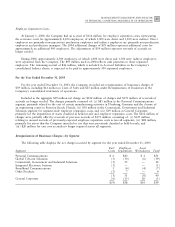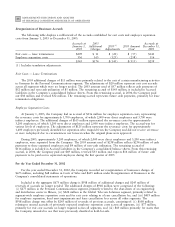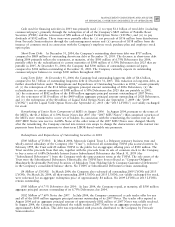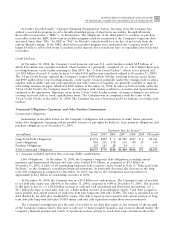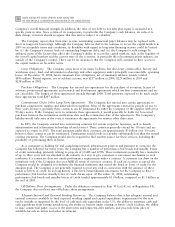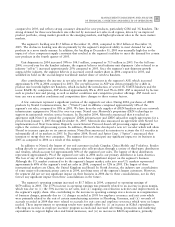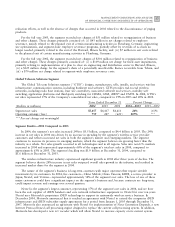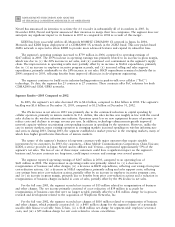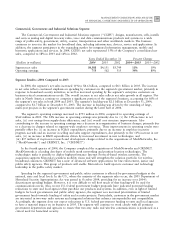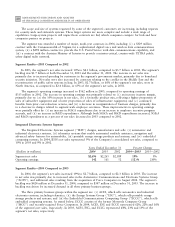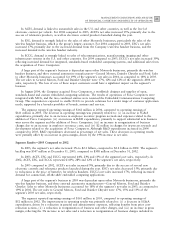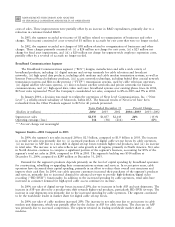Motorola 2004 Annual Report Download - page 61
Download and view the complete annual report
Please find page 61 of the 2004 Motorola annual report below. You can navigate through the pages in the report by either clicking on the pages listed below, or by using the keyword search tool below to find specific information within the annual report.
53
MANAGEMENT'S DISCUSSION AND ANALYSIS
OF FINANCIAL CONDITION AND RESULTS OF OPERATIONS
Customer Financing Commitments and Guarantees
Outstanding Commitments: Certain purchasers of the Company's infrastructure equipment continue to
request that suppliers provide Ñnancing in connection with equipment purchases. Financing may include all or a
portion of the purchase price of the equipment as well as working capital. The Company had outstanding
commitments to extend credit to third parties totaling $294 million at December 31, 2004, compared to
$149 million at December 31, 2003. During 2004, the Company made loans to customers of $25 million, as
compared to loans to customers of $32 million during 2003.
Guarantees of Third-Party Debt: In addition to providing direct Ñnancing to certain equipment customers, the
Company also assists customers in obtaining Ñnancing directly from banks and other sources to fund equipment
purchases. The amount of loans from third parties for which the Company has committed to provide Ñnancial
guarantees totaled $8 million at December 31, 2004, as compared to $10 million at December 31, 2003. No
payments were made pursuant to guarantees during 2004, compared to payments of $28 million made during 2003.
Customer borrowings outstanding under these third-party loan arrangements were $4 million at December 31, 2004,
as compared to $10 million at December 31, 2003.
The Company evaluates its contingent obligations under these Ñnancial guarantees by assessing the customer's
Ñnancial status, account activity and credit risk, as well as the current economic conditions and historical
experience. The $8 million of guarantees discussed above are to four customers and are scheduled to expire in
2013. The Company had no accrued liabilities recorded at December 31, 2004 and $1 million at 2003 to reÖect
management's best estimate of probable losses of unrecoverable amounts, should these guarantees be called.
Customer Financing Arrangements
Outstanding Finance Receivables: The Company had net Ñnance receivables of $170 million at December 31,
2004, compared to $301 million at December 31, 2003 (net of allowances for losses of $2.0 billion at
December 31, 2004 and $2.1 billion at December 31, 2003). These Ñnance receivables are generally interest bearing,
with rates ranging from 3% to 12%. Total interest income recognized on Ñnance receivables was $9 million in 2004,
compared to $18 million in 2003 and $28 million in 2002.
Telsim Loan: At December 31, 2004 and 2003, the Company had $1.9 billion and $2.0 billion, respectively,
of gross receivables from one customer, Telsim, in Turkey (the ""Telsim Loan'') with the decline representing
partial recovery of amounts owed of $44 million due to collection eÅorts during 2004. As a result of diÇculties in
collecting the amounts due from Telsim, the Company has previously recorded charges reducing the net receivable
from Telsim to zero. At both December 31, 2004 and 2003, the net receivable from Telsim was zero. Although the
Company continues to vigorously pursue its recovery eÅorts, it believes the litigation, collection and/or settlement
process will be very lengthy in light of the Uzans' (the family which previously controlled Telsim) continued
resistance to satisfy the judgment against them and their decision to violate various courts' orders, including orders
holding them in contempt of court. In addition, the Turkish government has asserted control over Telsim and
certain other interests of the Uzans and this may make the Company's collection eÅorts more diÇcult.
Sales of Receivables and Loans: From time to time, the Company sells short-term receivables and long-term
loans to third parties in transactions that qualify as ""true-sales.'' Certain of these receivables are sold through a
separate legal entity, Motorola Receivables Corporation (""MRC''). The Ñnancial results for MRC are fully
consolidated in the Company's Ñnancial statements. This receivables funding program is administered through multi-
seller commercial paper conduits. Under FASB Interpretation No. 46, ""Consolidation of Variable Interest Entities''
(revised), the Company is not required to consolidate those entities.
The Company sells short-term receivables through the Motorola Receivables Corporation (""MRC'') short-
term receivables program, which provides for up to $425 million of short-term receivables to be outstanding with
third parties at any time. In October 2004, the Company renewed the MRC short-term receivables program at its
current level for one year. In addition, the Company sells short-term receivables directly to third parties. Total
short-term receivables sold by the Company (including those sold directly to third parties and those sold through
the MRC short-term receivables program) were $3.8 billion in 2004, compared to $2.7 billion in 2003 and
$2.9 billion in 2002. There were $1.1 billion and $771 million of short-term receivables outstanding under these
arrangements at December 31, 2004 and 2003, respectively (including $255 million and $170 million, respectively,
under the MRC program). Under the MRC short-term receivables program, 90% of the value of the receivables
sold is covered by credit insurance obtained from independent insurance companies. The credit exposure on the
remaining 10% is covered by a retained interest in the sold receivables. The Company's total credit exposure to


